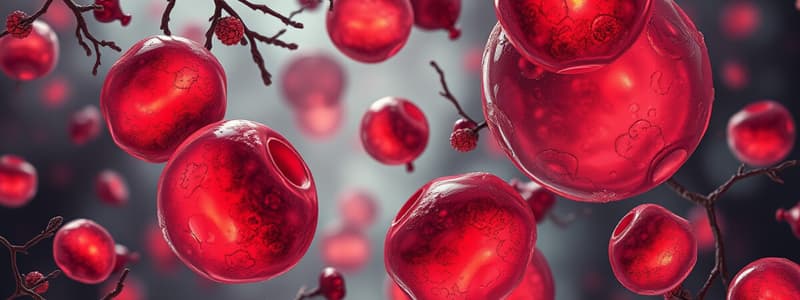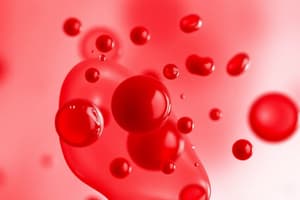Podcast
Questions and Answers
What compensatory mechanism may fail in patients with limited cardiac reserve when experiencing anemia?
What compensatory mechanism may fail in patients with limited cardiac reserve when experiencing anemia?
- Increased plasma volume
- Decreased cardiac output
- Increased cardiac output (correct)
- Diminished oxygen affinity of hemoglobin
Which type of anemia is characterized by a defect in hemoglobin synthesis?
Which type of anemia is characterized by a defect in hemoglobin synthesis?
- Macrocytic anemia
- Microcytic anemia (correct)
- Normocytic anemia
- Anemia due to inflammation
What effect does an increase in 2,3-diphosphoglycerate (2,3-DPG) have on hemoglobin's oxygen affinity?
What effect does an increase in 2,3-diphosphoglycerate (2,3-DPG) have on hemoglobin's oxygen affinity?
- It has no effect on hemoglobin.
- It decreases hemoglobin's oxygen affinity. (correct)
- It completely inhibits oxygen binding.
- It increases hemoglobin's oxygen affinity.
In morphologic classification of anemia, what condition is classified as macrocytic?
In morphologic classification of anemia, what condition is classified as macrocytic?
What is a potential cause for increased red blood cell loss in anemia?
What is a potential cause for increased red blood cell loss in anemia?
Which condition is associated with impaired red blood cell production?
Which condition is associated with impaired red blood cell production?
What is the result of increased plasma volume during anemia?
What is the result of increased plasma volume during anemia?
What type of anemia is characterized by megaloblastic macrocytic anemia caused by folate deficiency?
What type of anemia is characterized by megaloblastic macrocytic anemia caused by folate deficiency?
What is the primary consequence of anemia related to red blood cell (RBC) membrane structural defects?
What is the primary consequence of anemia related to red blood cell (RBC) membrane structural defects?
Which underlying mechanism can lead to anemia due to RBC enzyme defects?
Which underlying mechanism can lead to anemia due to RBC enzyme defects?
In terms of the structure and function of the body, anemia impacts which of the following?
In terms of the structure and function of the body, anemia impacts which of the following?
Which of the following is NOT considered a nutritional deficiency associated with anemia?
Which of the following is NOT considered a nutritional deficiency associated with anemia?
Which definition accurately describes anemia?
Which definition accurately describes anemia?
What is the primary purpose of a Complete Blood Count (CBC) in the evaluation of anemia?
What is the primary purpose of a Complete Blood Count (CBC) in the evaluation of anemia?
What is a potential clinical outcome of tissue hypoxia due to anemia?
What is a potential clinical outcome of tissue hypoxia due to anemia?
Which parameter of the Complete Blood Count measures the average volume of red blood cells?
Which parameter of the Complete Blood Count measures the average volume of red blood cells?
Anemia can be characterized as which of the following disorders?
Anemia can be characterized as which of the following disorders?
Which type of anemia is associated with a myelophthisic process?
Which type of anemia is associated with a myelophthisic process?
Which aspect of pathology is related to an anemia diagnosis?
Which aspect of pathology is related to an anemia diagnosis?
What role do RBC membrane structural defects play in the development of anemia?
What role do RBC membrane structural defects play in the development of anemia?
Which substance is essential for erythropoiesis and can be a deficiency-related cause of anemia?
Which substance is essential for erythropoiesis and can be a deficiency-related cause of anemia?
What does the Reticulocyte count indicate in the context of anemia evaluation?
What does the Reticulocyte count indicate in the context of anemia evaluation?
Which of the following is a common toxin that can lead to anemia?
Which of the following is a common toxin that can lead to anemia?
Which condition is most likely to cause a lack of erythropoietin, leading to anemia?
Which condition is most likely to cause a lack of erythropoietin, leading to anemia?
What is the primary change observed in sickle cell disease due to repeated cycles of sickling?
What is the primary change observed in sickle cell disease due to repeated cycles of sickling?
Which condition can precipitate sickling in individuals with sickle cell disease?
Which condition can precipitate sickling in individuals with sickle cell disease?
Which complication is most directly associated with vaso-occlusive crises in sickle cell disease?
Which complication is most directly associated with vaso-occlusive crises in sickle cell disease?
What characterizes sickle cell trait in carriers?
What characterizes sickle cell trait in carriers?
What mechanism leads to autosplenectomy in sickle cell disease?
What mechanism leads to autosplenectomy in sickle cell disease?
Which of the following findings is typically observed in peripheral blood of sickle cell disease patients?
Which of the following findings is typically observed in peripheral blood of sickle cell disease patients?
Aplastic crisis in sickle cell disease is primarily caused by which infection?
Aplastic crisis in sickle cell disease is primarily caused by which infection?
What is a potential consequence of autosplenectomy in sickle cell disease?
What is a potential consequence of autosplenectomy in sickle cell disease?
What leads to hemolysis in mature RBCs deficient in G6PD when exposed to oxidative stress?
What leads to hemolysis in mature RBCs deficient in G6PD when exposed to oxidative stress?
Which of the following could NOT contribute to iron deficiency anemia?
Which of the following could NOT contribute to iron deficiency anemia?
In individuals with G6PD deficiency, which substance can potentially trigger a hemolytic event?
In individuals with G6PD deficiency, which substance can potentially trigger a hemolytic event?
Which lab findings are indicative of severe iron deficiency anemia?
Which lab findings are indicative of severe iron deficiency anemia?
What characteristic is common among the majority of individuals with G6PD deficiency?
What characteristic is common among the majority of individuals with G6PD deficiency?
Which factor does NOT contribute to iron deficiency according to common causes?
Which factor does NOT contribute to iron deficiency according to common causes?
What is a common finding in the lab results of someone with severe iron deficiency anemia?
What is a common finding in the lab results of someone with severe iron deficiency anemia?
Which medication is known to potentially cause hemolysis in patients with G6PD deficiency?
Which medication is known to potentially cause hemolysis in patients with G6PD deficiency?
Flashcards are hidden until you start studying
Study Notes
Definition of Anemia
- Anemia is defined as a reduction in total circulating red cell mass, leading to decreased oxygen-carrying capacity and tissue hypoxia.
- Causes include decreased red blood cell count, diminished hemoglobin levels, or reduced red blood cell mass.
Physiological Compensatory Mechanisms
- Increased cardiac output; patients with existing heart conditions may experience symptoms at higher hemoglobin levels.
- Increased plasma volume enhances RBC efficiency by reducing viscosity.
- Elevated levels of 2,3-diphosphoglycerate (2,3-DPG) decrease hemoglobin's oxygen affinity, promoting oxygen delivery to tissues.
Classification of Anemias
- Morphologic:
- Microcytic: typically related to hemoglobin synthesis defects.
- Macrocytic: includes megaloblastic (B12, folate deficiencies) and non-megaloblastic types (due to alcohol, liver disease, hypothyroidism).
- Normocytic: related to inflammation, acute hemolysis, blood loss, or chronic kidney disease.
- Pathophysiologic:
- Increased RBC loss: hemorrhage (external/internal) and hemolysis (immune, microangiopathic, intrinsic defects).
- Impaired red cell production: can be stem cell-related, nutritional deficiencies, toxin/drug-induced, lack of erythropoietin, or due to myelophthisic processes.
Laboratory Evaluation of Anemia
- Focuses on confirming anemia and identifying its underlying cause.
- Complete Blood Count (CBC) provides information including:
- Hemoglobin (g/dL): primary RBC component.
- Hematocrit (%): percentage of blood volume occupied by RBCs.
- RBC indices:
- Mean Cell Volume (MCV): average volume of RBCs.
- Mean Cell Hemoglobin (MCH): average mass of hemoglobin per RBC.
- Mean Cell Hemoglobin Concentration (MCHC): average concentration of hemoglobin in packed RBC volume.
- Red Cell Distribution Width (RDW): measures variability in RBC volume.
Sickle Cell Disease
- Sickle cell disease arises from hemoglobin S (HbS); repeated sickling results in membrane damage, hemolysis, and vaso-occlusive crisis.
- Factors precipitating sickling include low oxygen saturation, high altitude, acidosis, and infections.
- Newborns have high HbF levels, delaying sickling until about 6-9 months.
- Sickle cell trait is common among African Americans, providing malaria resistance without significant symptoms.
Complications of Sickle Cell Disease
- Chronic hemolytic anemia and vaso-occlusive pain crises affecting bones, lungs, and other organs.
- Aplastic crises can occur suddenly due to infections like Parvovirus B19.
- Sequestration crises result from sudden splenic accumulation of RBCs, increasing infection risk due to autosplenectomy.
G6PD Deficiency
- G6PD deficiency leads to vulnerability to oxidative stress, causing hemolysis during exposure to certain chemicals, medications, and foods.
- Many affected individuals remain asymptomatic and face no hemolysis during steady states.
Iron Deficiency Anemia
- Most common nutritional deficiency globally; driven by factors such as inadequate intake, impaired absorption, increased demand during pregnancy, and chronic blood loss.
- Lab findings typically show low hemoglobin, low reticulocyte counts, low serum iron, and decreased transferrin saturation.
Studying That Suits You
Use AI to generate personalized quizzes and flashcards to suit your learning preferences.




